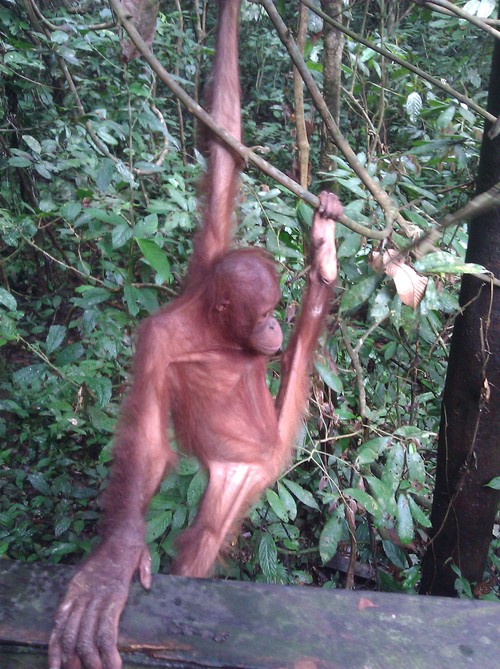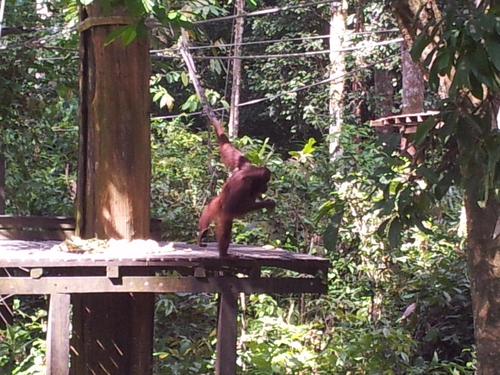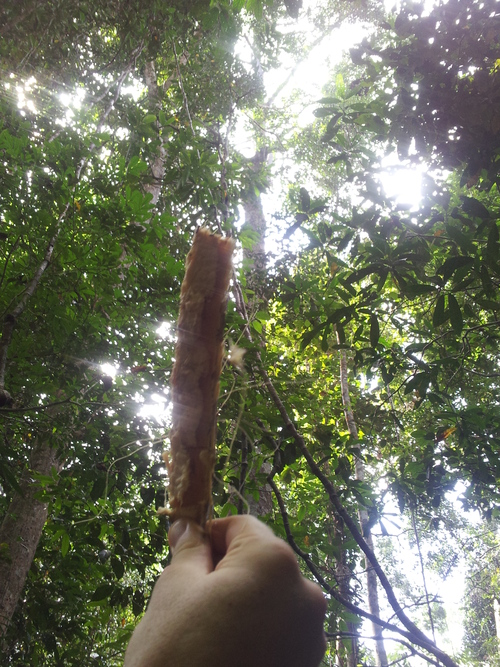03 February 2014
Orang Utan – ‘Man of the Forest’

A long time dream of ours has been to see orangutans in the wild. These funny creatures are beautiful, weird and fascinating. The dwindling natural habitats of Borneo and Sumatra (the home of these apes) threaten to erase this species altogether.
In Malay, ‘orang’ means person (man) and ‘utan’ means ‘forest’ so the direct translation might be forest-person but the locals refer to it as ‘Man of the Forest’ when entertaining questions from curious tourists.
Orangutan facts
- The Orangutans are the only apes that inhabit Asia.
- They are highly intelligent and naturally solitary.
- The Borneo male’s armspan can reach up to 7 feet (2 metres) and male orangutans have distinctive black cheeks and fleshy jowls.
- They can not swim, unlike so many of the other animals that make their home in the rainforests of Borneo.
- The mother and baby will stay together for up to seven years until the baby is ready to go it alone in the wild.
- Females only give birth once every eight years, which is why the numbers of orangutans are decreasing so quickly and also why there is such a need for the Sepilok sanctuary to care for orphaned baby orangutans.
- They use big leaves as umbrellas against the regular downpours and branches to make sleeping nests.
- There diet consists of fruit and leaves and they spend 90% of their time in the trees. This is why deforestation is so detrimental to orangutan populations.
Sanctuary

Due to the dire need to protect this special animal from deforestation and clashes with humans over crops and livelihoods, the Sepilok sanctuary was established in 1964. Its main purpose was to care for orphaned orangutans and rehabilitate them back in to the wild. The Kabili-Sepilok Sanctuary is 4,300 hectares of natural jungle and there are said to be almost 75 rehabilitated orangutans in the reserve.
Feeding time
The sanctuary has to feed some of the juvenile orangutans who have not yet learned to forage for themselves and they estimate that only 20% of the total orangutan population in Sepilok actually come to the feeding sites each week.
 Bird trail
Bird trail
Within the sanctuary there walking trails. From the Orangutan Sanctuary you can do the “Bird Trail” – a 2.2 kilometer (total) walk through the jungle to a bird viewing tower that overlooks the canopy. It is not an easy walk so be sure to take proper walking shoes and water with you. It can be muddy when raining and there are lots of roots and trees to clamber over along the way. We didn’t know it, but the trail actually closes at 2 p.m. so make sure you are back through the gate near the orangutan feeding section before 2 p.m.
Special memory along the bird trail

After walking for more than an hour, not seeing anything besides a troop of short-tailed macaques, we were almost smacked on the head by a half eaten pod. More pods and sticks came down in the next few minutes and no matter how hard we strained our eyes, we could not see the culprit who was trying to murder us.
Eventually, we spotted a small orangutan at the very top of the jungle canopy and we walked away with a half-eaten pod as a souvenir (and to prove to other people that the Bird trail was not a complete waste of time).
Wildlife
This is a reserve in which you can find orangutans, short-tailed and long-tailed macaques, squirrels (including giant flying squirrel), snakes, deer, a staggering variety of endemic birds (including the rare Great Argus) and other reptiles.
Admission
MYR 30 each for a one day pass. (Sun Bear Sanctuary is also MYR 30 each, Rainforest Discovery Centre MYR 15 each)
Tips: Visitors are not allowed to take any food or drink into the sanctuary as the animals may try to steal. There are (Free) lockers available at the office where you can leave your bags (small bags/backpacks only).
Bus
From Sandakan, Take the ‘14 Sepilok’ bus directly to Sepilok Orangutan Sanctuary. It leaves from the mini-bus terminal near the beachfront traffic circle (5 minutes walk from Harbor Square Mall). Bus trip takes about 50 minutes, RM5 (negotiable) and it leaves at 9.00am and 14.00pm from Sandakan to get you there just in time for the 10.00 am and 15.00 pm feedings.
Day trip options from Sandakan
Sepilok One Day:
Orangutan sanctuary 10.00 feeding, Sun Bear sanctuary 12.00 – 13.00, Rainforest discovery Centre 13.00 – 14.00, Orangutan sanctuary 15.00 feeding. Bus back to Sandakan at 16.00
*Recommended*
Sepilok Two Days:
- DAY 1: Orangutan sanctuary 10.00 feeding, Bird Trail and lunch 11.30 – 14.00, Informational video 14.30, Orangutan 15.00, Bus back to Sandakan at 16.00
- DAY 2: Rainforest Discovery Centre morning, lunch outside the Orangutan Centre at local stall, Sunbear Sanctuary afternoon. Take the 9.00 a.m. Bus 14 from Sandakan, ask to be dropped at Rainforest Discovery Centre. Take 16.00 bus back to Sandakan from the Sepilok Orangutan Sanctuary. (Note: Rainforest discovery centre is about 1.2km walk from the Sunbear and Orangutan Sanctuaries)
You can read more about Sepilok Reserve, Orangutan Rehabilitation Centre and Rainforest Discovery Centre here.



 Turns out, it was a small orangutan! A real, live, wild orangutan in the forest where we had only expected to be seeing birds and bugs. We strained our necks and happily watched him for at least an hour, eating and playing on one of the lower trees.
Turns out, it was a small orangutan! A real, live, wild orangutan in the forest where we had only expected to be seeing birds and bugs. We strained our necks and happily watched him for at least an hour, eating and playing on one of the lower trees.
 Sandakan is a small city on the east coast of Sabah, Malaysia Borneo. It is a port city and relies heavily on the palm oil trade, as well as other exports like cocoa, tobacco and sago.
Sandakan is a small city on the east coast of Sabah, Malaysia Borneo. It is a port city and relies heavily on the palm oil trade, as well as other exports like cocoa, tobacco and sago.